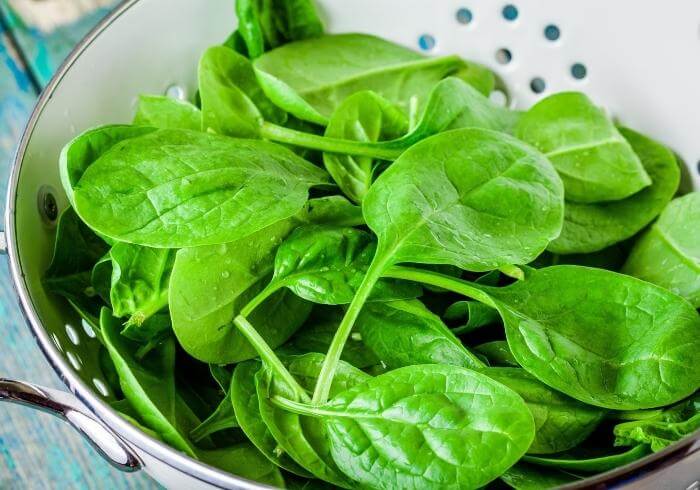Nobody wants to eat bad food, especially not something as healthy as spinach. But spinach is a notoriously perishable vegetable and can catch you off guard as you look in the fridge, hoping to make a fresh salad. Luckily, it’s not too hard to tell if your spinach has gone bad.
The best way to tell that spinach has gone bad is first by how it looks, wilted, with yellow leaves, or slimy. Even before the presence of mold, spinach will start to smell bad as it decays, which is the biggest sign it needs to be thrown out and not cooked or consumed.

Read on to learn more about how to tell when spinach is bad. This information will help you avoid eating expired spinach, give a heads-up of what to avoid at the grocery store, and save you from getting sick.
How To Know If Spinach Is Bad
Old Spinach
When you buy a bag of spinach at the grocery store, it should have a sell-by date. This is the date by which the grocery store needs to sell the spinach so that it is still considered fresh.
After this date, the quality of the spinach starts to decline even though it may not be bad yet. The key is to buy spinach that has been recently packaged and has a later sell-by date.
But the biggest problem is that spinach can go bad quickly, long before the sell-by date, depending on how it’s handled and stored. Heat and moisture have the biggest influences on keeping your spinach fresh, which I’ll mention below.
If your spinach has been in your fridge for more than a week, it is probably best to throw it out, no matter how fresh it may look.
Wilting Leaves
As the spinach plant cells begin to break down and lose moisture, the leaves will start to wilt.
If you have wilted spinach, sometimes you can place the spinach in cold water for an hour to help bring back its crisp texture. It’s quite amazing to see the transformation.
Wilting from heat damage during cooking can not be revived in the same way.
Wilted leaves should be used immediately before other signs of spoilage show up.
Spinach Leaves Are Turning Yellow
Eventually, the leaves of your spinach will start turning from green to yellow. This indicates that chlorophyll is breaking down, the chemical responsible for the green color.
Similar to asparagus, it’s not uncommon for wilting and yellowing leaves to happen around the same time.
I don’t recommend using yellow spinach leaves. They’ll taste awful and will break apart when cooked much quicker than green leaves.
Slimy Spinach
Too much moisture can damages the leaves. Once the leaves are damaged or have broken down due to age, it accelerates decomposition. If your spinach is slimy, it’s literally decomposing plant matter.
During this time, bacteria will thrive on the slimy goo. You can’t save it at this point and should throw it out or compost it.
Spinach Smells Bad
Now that your spinach is slimy, it will start to smell. If you’ve ever smelt a swamp or opened up a compost heap, you know how pungent decaying plant matter can be.
Spinach is no different when locked away in a plastic bag at the bottom of the fridge. It can be quite gross.
If your spinach smells bad, it’s bad. There’s no saving it. The whole bag needs to be tossed in the garbage or compost.
Moldy Spinach
One sign that may you may find earlier or later is mold. While mold may make an appearance in a variety of colors on your spinach, I’ve seen fuzzy white and blue colored mold the most.
Mold loves organic materials such as spinach and moisture. It thrives with both of those elements present. While its growth may be slowed in the refrigerator, it doesn’t stop it completely.
If you find mold at any point in your spinach’s journey in your kitchen, throw it all out. Mold spores not visible to you will have spread everywhere and could make you sick if consumed. You should also check any other fruits or vegetables for mold that were stored nearby.
No, do not wash it or attempt to cook it. It’s bad. Tie it up in a plastic bag and get rid of it!
What Does Bad Spinach Look Like?
Typically bad spinach looks like any other vegetable when it’s starting to go bad. The leaves will wilt, turn yellow, and start breaking down into a slimy mess.
If you see mold or anything that looks like dirt, give it a closer inspection. If it’s just dirt, give the spinach a rinse under cold water. If it’s mold, get rid of it!
Bad Spinach FAQs
Can You Eat Spinach Past Use By Date?
No, you should not eat spinach after the use-by date. The sell-by date is there to tell you when the store needs to remove the spinach from their shelves. The use-by date is when the spinach is no longer safe for consumption, regardless of how it looks or smells.
What Happens If You Eat Bad Spinach?
In some cases, eating bad spinach can lead to more serious issues, such as food poisoning. Food poisoning can cause fever, chills, headache, and worse in severe cases. You should never use or consume bad spinach.
Is Wet Spinach Bad?
Wet spinach that is not slimy is not necessarily bad. However, it can start to deteriorate quicker than dry spinach. I recommend transferring wet spinach to a colander and allowing it to air dry for a bit before using or storing it.











